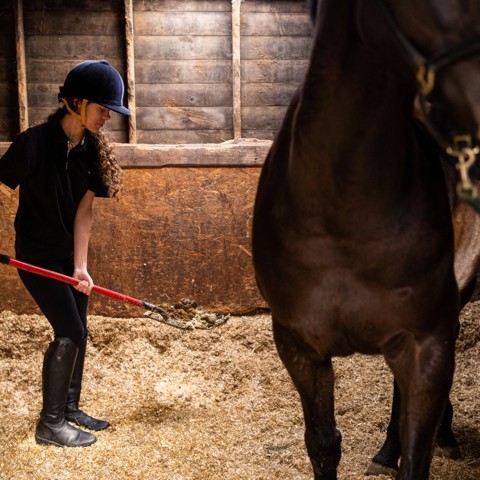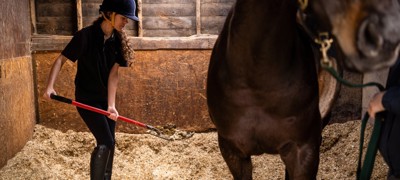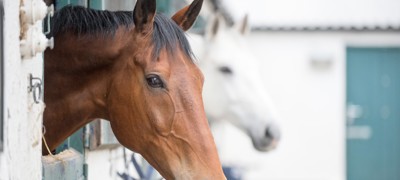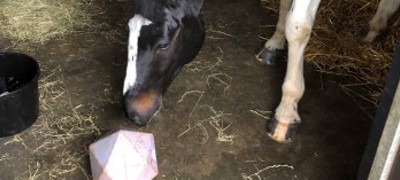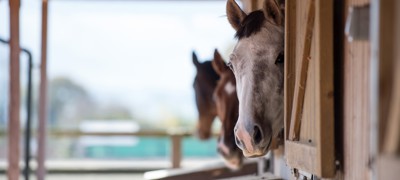Straw
Straw is the most traditional bedding and has been used for centuries. There are three main types of straw available – wheat, barley and oat. Some horses will consume straw bedding, meaning that it is not an appropriate choice for all stables.
Advantages
- Straw is readily available, however the time of year may slightly increase the cost as harvest approaches and stocks are low
- It is a relatively cheap bedding material
- It is easy to use
Disadvantages
- Straw can vary greatly in quality and may contain high levels of dust and mould spores
- Straw beds are rarely odourless and the muckheap can be both large and difficult to keep tidy
- Straw may not be a suitable type of bedding for horses or carers who are susceptible to respiratory disorders, or for horses that eat their bedding.
Wheat straw
chevron-down
chevron-up
Wheat straw is the most common type used. It makes a warm, comfortable bed that is easy to handle as well as allowing free drainage. Wheat straw is usually readily available although it does tend to be the dustiest straw.
Barley straw
chevron-down
chevron-up
Barley straw is often the least expensive but is not always the most suitable for horses. The ears in the straw can be very prickly and may cause skin irritations.
Oat straw
chevron-down
chevron-up
Oat straw is often of higher quality and more golden in colour. However, horses can be more inclined to eat this type of straw. It also tends to be more absorbent, which can make it become heavier to muck out.
Treated straw products
chevron-down
chevron-up
Treated straw products consist of chopped straw that is sometimes mixed with other bedding materials. Essential oils are also sometimes added. This type of bedding tends to be more consistent in quality than conventional straw. Treated straw bedding comes in wrapped bales that are easier to store than traditional straw bales but this type of bedding can be more expensive than other types of straw.
Wood shavings
Wood shavings have been a popular horse bedding for many years, and are often used for horses that suffer from respiratory disease, or those that tend to eat other types of bedding. The quality of wood shavings varies greatly, particularly in respect of the dust content. Dust extracted shavings are the most popular as they are of a higher quality and have a low dust content. Low quality shavings, often a sawmill by-product, are not suitable for horse bedding as they can be contaminated with sharp splinters and other potentially dangerous waste. The brands of shaving with the largest flakes are usually produced from virgin wood and can have lower dust content. Wood shavings do provide excellent support for the horse’s hooves as they compact inside them. Shavings are usually packed in polythene wrapped bales, making them easy to stack and store.
Shredded wood fibre
Shredded wood fibre is specifically manufactured from selected recycled white wood, making it one of the ‘greenest’ bedding products available. This product has low dust levels and is absorbent, which helps to keep the surface of the bed dry. It is less likely to move around, so may help to reduce the risk of injury when the horse gets up and lies down. The quality of shredded wood fibre is of a consistently high quality and it is widely available. It also offers support to the hooves and is easy to manage with very little waste, so producing one of the smallest muck heaps.
Flax and hemp
Flax and hemp bedding materials are made from the chopped stems of flax and hemp plants. This bedding material has become increasingly popular in recent years and has a low dust content. This bedding can often be more expensive, which may limit its appeal. Instances of horses eating the bedding are rare but have been reported so it is important to look out for this as flax and hemp are relatively indigestible. It is packaged in heavy duty plastic bags so can easily be stored.
Paper
Paper is usually shredded and consists of a mix of newspaper, magazines and other unwanted printed matter, with varying absorbency. The key advantages of paper are that it has low dust levels and is a non-palatable bedding material. However, the long paper strips tend to be harder to muck out as they can stick together and become difficult to separate from the droppings. Bales usually come wrapped in polythene making them easy to store. Paper is one of the cheaper types of bedding, but a large number of bales may be needed to create a thick bed and ink can also stain a light coloured coat. When wet, paper can become less user-friendly and very soggy.
Cardboard
Cardboard is usually shredded and is another low dust bedding material. It can, however, move around the stable like paper, leaving bare patches when the horse gets up and lies down. Cardboard clumps together when wet, making removal of theses patches easy, but it can be difficult to separate from droppings, which can be wasteful.
Rubber matting
Rubber matting has become commonplace as a partial alternative to bedding in stables. Although the matting is initially expensive, it should be viewed as a long-term investment.
Rubber matting provides excellent support for the horse’s hooves and limbs and minimises the risk of injury as it covers the concrete floor and provides better grip. Rubber flooring comes in separate mats that interlock, or it can come in a liquid that forms a seamless floor that does not have to be lifted for cleaning.
We strongly advise that a good layer of bedding material is added on top of the mats, as this will help soak up urine and contain droppings. Some people choose to use rubber matting without any bedding, although we at the BHS do not endorse this practice. This management option can lead to wet floors, dirty rugs and horses. Many horses do not like to urinate on hard surfaces, so adding bedding will help prevent this problem.
Hygiene standards need to be high when using rubber matting. Mats will need to be uplifted and thoroughly cleaned underneath to prevent a build up of ammonia and dirty bedding material. Ideally, this should be performed a minimum of once a month, and more regularly during the hotter summer months.
Overall, rubber matting is easy to manage and although the initial cost is high, the amount of bedding used can be significantly reduced, saving time mucking out and reducing the size of the muckheap.
Purchase of bedding
Local feed merchants and country stores stock many different types of bedding and are often able to order in a particular product for a client. Bedding suppliers may deliver large amounts directly to individual yards or local stockists. Buying in bulk on large yards can help to reduce costs.
Straw is usually purchased from a local farmer, who will often deliver to your yard. Quality of straw and price per bale will vary between different suppliers.
Some livery yard clients may find that the yard owner provides bedding included in the cost of livery, or it is available for sale from them. This is often easier, but it can be difficult if you want to use a different product.

